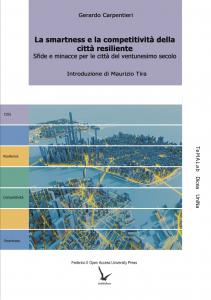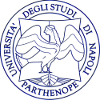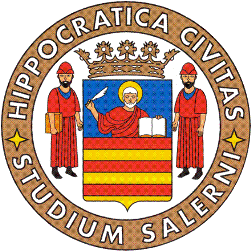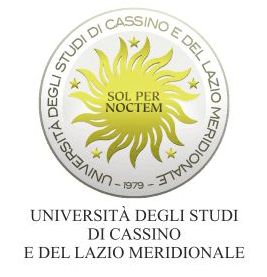La smartness e la competitività della città resiliente. Sfide e minacce per le città del ventunesimo secolo
Keywords:
Resilienza, Sviluppo urbano, Smartness, CompetitivitàSinossi
Editore: FedOA Press (Federico II Open Access University Press).
Collana: Smart City, Urban Planning for a Sustainable Future.
Pagine: 126.
Lingua: Italiano
NBN: http://nbn.depositolegale.it/urn:nbn:it:unina-26413
Abstract: Le numerose e complesse sfide economiche, sociali e ambientali che dovranno essere affrontare nei prossimi decenni nell’ambito del governo delle trasformazioni urbane e territoriali richiederanno l’impiego di nuovi approcci in grado di orientare lo sviluppo dei contesti territoriali verso una sostenibilità sociale, economica e ambientale. Le scelte e gli interventi di trasformazione dovranno garantire un’adeguata qualità della vita ai cittadini e favorevoli condizioni per lo sviluppo delle attività economiche e sociali. Tra le sfide che le città dovranno affrontare nei prossimi anni vi è quella della crescita della popolazione urbana. Le proiezioni demografiche prevedono che nei prossimi decenni vi sarà un ulteriore incremento della popolazione mondiale che interesserà principalmente le aree urbane. Queste previsioni sottolineano ancor di più la necessità d’intervenire in maniera prioritaria nelle città al fine di ridurre gli effetti delle possibili minacce che possono verificarsi a seguito di eventi critici improvvisi di natura antropica e naturale. Negli ultimi anni, i governi nazionali e locali hanno programmato d’investire ingenti risorse economiche per lo sviluppo e la realizzazione d’interventi in grado di affrontare alle possibili criticità dei sistemi urbani. Nell’ambito del governo delle trasformazioni urbane uno degli approcci più utilizzati per migliorare la capacità di risposta dei sistemi urbani al verificarsi di sollecitazioni esterne fa riferimento al paradigma della resilienza intesa come la capacità di un sistema, di una comunità o di una società esposta a pericoli di resistere, assorbire, adattarsi e riprendersi dagli impatti di un evento calamitoso in modo tempestivo ed efficiente, anche attraverso la conservazione e il ripristino delle sue strutture e funzioni di base essenziali. L’implementazione di soluzioni orientate al miglioramento della resilienza urbana risulta ormai essenziale per ridurre i possibili impatti economici, sociali ed ambientali dovuti ad eventi critici che possono interessare le città. Inoltre, l’impiego di questo approccio può offrire una maggiore sicurezza ai cittadini e alle attività economiche, sia in condizioni ordinarie che in condizioni d’emergenza. Il soddisfacimento di questa esigenza è ormai diventato un elemento fondamentale nella competizione tra i diversi contesti territoriali ed in particolare tra le città. Gli studi più recenti sulla competitività urbana evidenziano come il tema dello sviluppo della resilienza urbana è diventato un aspetto imprescindibile nel valutare le capacità competitive dei diversi contesti territoriali. La messa a punto e l’implementazione d’interventi orientati a rendere le città resilienti non possono prescindere dall’impiego di soluzioni, fisiche e funzionali, di tipo smart che ormai costituiscono un supporto essenziale nel migliorare la capacità di risposta che le città e le sue componenti sono in grado di offrire al verificarsi di sollecitazioni interne ed esterne. Rendere una città resiliente richiede la realizzazione d’interventi, infrastrutturali e organizzativi, complessi che devono considerare la molteplicità e la dinamicità delle componenti urbane coinvolte e che quindi non possono prescindere dall’impiego delle più recenti tecnologie, hardware e software. Intervenire sulla resilienza urbana può consentire alle città di conseguire anche un migliore livello di smartness. ln questo ampio dibattito scientifico si inseriscono gli approfondimenti e le considerazioni raccolte in questo volume. In particolare, la finalità di questo lavoro è approfondire le tematiche connesse alle sfide che le città dovranno affrontare nei prossimi decenni per garantire un’adeguata qualità della vita ai cittadini, evidenziando come l’impiego di un approccio resiliente può migliorare la risposta che questi contesti territoriali al verificarsi di situazioni di criticità. Vengono studiati nel dettaglio i temi della competitività territoriale e della smartness urbana all’interno di un nuovo modo di pensare scientifico, tecnico e culturale che fa della resilienza il paradigma di riferimento primario. Ciò al fine di comprendere quanto lo sviluppo resiliente è in grado di supportare sia il miglioramento della capacità di una città di competere con altri contesti territoriali, sia di favorire il conseguimento di un adeguato livello di smartness urbana. L’obiettivo è quello di mettere a punto un quadro di riferimento scientifico, dettagliato e aggiornato, sulle principali esigenze e criticità che le città sono chiamate a fronteggiare e sulla necessità di promuovere l’utilizzo di un approccio orientato al miglioramento della resilienza urbana, nell’ottica di affrontare le sollecitazioni e i cambiamenti esterni ed interni che interessano questi contesti territoriali. In altre parole, si mettono in luce le relazioni che si possono instaurare tra lo sviluppo della città resiliente sia con la capacità di un sistema urbano di competere con altri contesti territoriali che con le potenzialità offerte dall’impego di soluzioni smart, fisiche e funzionali, in ambito urbano.
Downloads
Riferimenti bibliografici
Akerlof, G. A. (1978). The market for “lemons”: Quality uncertainty and the market mechanism. In Uncertainty in economics, 235-251. Academic Press. https://doi.org/10.1016/B978-0-12-214850-7.50022-X
Alberti, M., Marzluff, J. M., Shulenberger, E., Bradley, G., Ryan, C., & Zumbrunnen, C. (2003). Integrating humans into ecology: Opportunities and challenges for studying urban ecosystems. BioScience, 53 (12), 1169–1179. http://dx.doi.org/10.1641/0006-3568(2003)053
Albino, V., Berardi, U., & Dangelico, R. M. (2015). Smart cities: Definitions, dimensions, performance, and initiatives. Journal of urban technology, 22 (1), 3-21. https://doi.org/10.1080/10630732.2014.942092
Alexander, D. (1989). Urban landslides. Progress in Physical Geography, 13 (2), 157-189. https://doi.org/10.1177/030913338901300201
Amin, A. (1999). An institutionalist perspective on regional economic development. International journal of urban and regional research, 23(2), 365-378. https://doi.org/10.1111/1468-2427.00201
Anderws, F. M. (1976). Social Indicators of Well-Being: America’s Perception of Life Quality/FM Andrews, SB Withey.
Andrews, F. M. (1974). Social indicators of perceived life quality. Social indicators research, 1 (3), 279-299. https://doi.org/10.1007/BF00303860
Andrews, F. M., & Withey, S. B. (2012). Social indicators of well-being: Americans' perceptions of life quality. Springer Science & Business Media.
Angelidou, M. (2014). Smart city policies: A spatial approach. Cities, 41, S3-S11. https://doi.org/10.1016/j.cities.2014.06.007
Anthopoulos, L. (2017). Smart utopia VS smart reality: Learning by experience from 10 smart city cases. Cities, 63, 128-148. https://doi.org/10.1016/j.cities.2016.10.005
Anthopoulos, L. G. (2017). The rise of the smart city. In Understanding Smart Cities: A Tool for Smart Government or an Industrial Trick?, 5-45. Springer, Cham. https://doi.org/10.1007/978-3-319-57015-0_2
Anthopoulos, L. G., & Vakali, A. (2012). Urban planning and smart cities: Interrelations and reciprocities. In The Future Internet Assembly (178-189). Springer, Berlin, Heidelberg.
Arafah, Y., & Winarso, H. (2017). Redefining smart city concept with resilience approach. In IOP Conf. Series: Earth and Environmental Science, 70, 1-13. http://dx.doi.org/10.1088/1755-1315/70/1/012065
Arora, A., Florida, R., Gates, G. J., & Kamlet, M. (2000). Human capital, quality of place, and location. Pittsburgh, PA: Carnagie Mellon University.
Astengo, G. (1966). voce Urbanistica in Enciclopedia Universale dell’Arte, vol. XIV, Sansoni, Venezia.
ASVIS (2107). L’Agenda urbana per lo sviluppo sostenibile. Obiettivi e proposte. Disponibile al link: https://asvis.it/public/asvis/files/Agenda_Urbana_2019_1_.pdf
Audretsch, D. B., & Keilbach, M. (2004). Entrepreneurship and regional growth: an evolutionary interpretation. Journal of Evolutionary Economics, 14(5), 605-616. https://doi.org/10.1007/s00191-004-0228-6
Bansal, N., Mukherjee, M., & Gairola, A. (2017). From poverty, inequality to Smart City. Springer Transactions in Civil & Environmental Engineering, 109–122. https://doi.org/10.1007/978-981-10-2141-1.
Barca, F. (2009). Agenda for a reformed cohesion policy. Brussels: European Communities.
Baron, M. (2012). Do we need smart cities for resilience. Journal of Economics & Management, 10, 32-46.
Battarra, R., Fistola, R., & La Rocca, R. A. (2016). City SmartNESS: the energy dimension of the urban system. In Smart Energy in the Smart City (1-23). Springer, Cham. https://doi.org/10.1007/978-3-319-31157-9_1
Batty, M. (1995). New ways of looking at cities. Nature, 377 (6550), 574-574.
Batty, M. (2008). The size, scale, and shape of cities. Science, 319 (5864), 769-771. https://doi.org/10.1126/science.1151419
Batty, M., & Marshall, S. (2009). The evolution of cities: Geddes, Abercrombie and the new physicalism. Centenary paper. Town Planning Review, 80 (6), 551-574.
Beatley, T. (1995). Planning and sustainability: The elements of a new (improved?) paradigm. Journal of planning literature, 9(4), 383-395. https://doi.org/10.1177/088541229500900405
Begg, I. (1999). Cities and competitiveness. Urban studies, 36(5-6), 795-809.
Belanche, D., Casaló, L. V., & Orús, C. (2016). City attachment and use of urban services: Benefits for smart cities. Cities, 50, 75-81.
Bettencourt, L. M., Lobo, J., Helbing, D., Kühnert, C., & West, G. B. (2007). Growth, innovation, scaling, and the pace of life in cities. Proceedings of the national academy of sciences, 104 (17), 7301-7306. https://doi.org/10.1073/pnas.0610172104
Biagi, B., Ladu, M. G., & Meleddu, M. (2018). Urban quality of life and capabilities: An experimental study. Ecological Economics, 150, 137-152. https://doi.org/10.1016/j.ecolecon.2018.04.011
Birkmann, J., Garschagen, M., Kraas, F., & Quang, N. (2010). Adaptive urban governance: new challenges for the second generation of urban adaptation strategies to climate change. Sustainability Science, 5 (2), 185-206. https://doi.org/10.1007/s11625-010-0111-3
Blowers, A., & Pain, K. (1999). The unsustainable city?. Unruly Cities? Order/Disorder, 247-298.
Boddy, M. (1999). Geographical economics and urban competitiveness: a critique. Urban Studies, 36(5-6), 811-842. https://doi.org/10.1080/0042098993231
Borie, M., Pelling, M., Ziervogel, G., & Hyams, K. (2019). Mapping narratives of urban resilience in the global south. Global Environmental Change, 54, 203-213. https://doi.org/10.1016/j.gloenvcha.2019.01.001
Brown, J., & Mczyski, M. (2009). Complexcities: Locational choices of creative knowledge workers. Built Environment, 35(2), 238-252. https://doi.org/10.2148/benv.35.2.238
Brugmann, J. (1996). Planning for sustainability at the local government level. Environmental Impact Assessment Review, 16(4-6), 363-379. https://doi.org/10.1016/S0195-9255(97)81658-7
Brugmann, J. (2012). Financing the resilient city. Environment and Urbanization, 24 (1), 215-232. https://doi.org/10.1177/0956247812437130
Bruneckienė, J., Činčikaitė, R., & Kilijonienė, A. (2012). The specifics of measurement the urban competitiveness at the national and international level. Inžinerinė ekonomika, 256-270. https://doi.org/10.5755/j01.ee.23.3.1272
Buck, N. H., Gordon, I., Harding, A., & Turok, I. (2005). Changing cities: Rethinking urban competitiveness, cohesion, and governance. Macmillan International Higher Education. https://doi.org/10.1007/978-0-230-21203-9
Buck, N. H., Gordon, I., Harding, A., & Turok, I. (Eds.). (2005). Changing cities: Rethinking urban competitiveness, cohesion, and governance. Macmillan International Higher Education. ISBN 978-1-4039-0680-9. https://doi.org/10.1007/978-0-230-21203-9
Cairney, T., & Speak, G. (2000). Developing a Smart City: Understanding Information Technology Capacity and Establishing an Agenda for Change. Centre for Regional Research and Innovation, University of Western Sydney.
Camagni, R. (2002). On the concept of territorial competitiveness: sound or misleading?. Urban studies, 39(13), 2395-2411. https://doi.org/10.1080/0042098022000027022
Camagni, R., & Capello, R. (2005). ICTs and territorial competitiveness in the era of internet. The Annals of Regional Science, 39(3), 421-438. https://doi.org/10.1007/s00168-005-0244-y
Camagni, R., Gibelli, M. C., & Rigamonti, P. (2002). Urban mobility and urban form: the social and environmental costs of different patterns of urban expansion. Ecological economics, 40 (2), 199-216. https://doi.org/10.1016/S0921-8009(01)00254-3
Campanella, T. J. (2006). Urban resilience and the recovery of New Orleans. Journal of the American planning association, 72 (2), 141-146. https://doi.org/10.1080/01944360608976734
Campbell, A., Converse, P. E., & Rodgers, W. L. (1976). The quality of American life: Perceptions, evaluations, and satisfactions. Russell Sage Foundation.
Caragliu, A., Del Bo, C., & Nijkamp, P. (2011). Smart cities in Europe. Journal of urban technology, 18 (2), 65-82. https://doi.org/10.1080/10630732.2011.601117
Caragliu, A., Del Bo, C., Nijkamp, P. (2009). Smart cities in Europe. Proceedings of the 3rd Central European Conference in Regional Science (Košice, Slovak Republic, Oct 7-9). Available at: http://www.cers.tuke.sk/cers2009/PDF/01_03_Nijkamp.pdf
Carli, R., Dotoli, M., Pellegrino, R., & Ranieri, L. (2013). Measuring and managing the smartness of cities: A framework for classifying performance indicators. In 2013 IEEE international conference on systems, man, and cybernetics (1288-1293). IEEE. https://doi.org/10.1109/SMC.2013.223
Chelleri, L. (2012). From the «Resilient City» to Urban Resilience. A review essay on understanding and integrating the resilience perspective for urban systems. Documents d'anàlisi geogràfica, 58 (2), 287-306. https://doi.org/10.5565/rev/dag.175
Cheshire, P. (2009). Spatial policies, planning and urban competitiveness: the particular case of London. Edward Elgar, Cheltenham.
Chourabi, H., Nam, T., Walker, S., Gil-Garcia, J. R., Mellouli, S., Nahon, K., ... & Scholl, H. J. (2012, January). Understanding smart cities: An integrative framework. In 2012 45th Hawaii international conference on system sciences, 2289-2297. IEEE. doi: https://doi.org/10.1109/HICSS.2012.615
Carpentieri, G., Zucaro, F., Guida, C., & Granata, L. (2019). GIS-Based Spatial Analysis for the Integrated Transport-Land Use-Energy Planning: An Application to the Great London Area. Journal of Civil Engineering and Architecture, 13, 469-481. doi: https://doi.org/10.17265/1934-7359/2019.09.001
Christaller, W. (1966). Central places in southern Germany. Prentice Hall.
Cities, S. G., Sites, P. P., & as Class, N. E. R. (2001). The Global City: New York, London, Tokyo.
Coaffee, J. (2008). Risk, resilience, and environmentally sustainable cities. Energy Policy, 36 (12), 4633-4638. https://doi.org/10.1016/j.enpol.2008.09.048
Coaffee, J. (2010). Protecting vulnerable cities: the UK's resilience response to defending everyday urban infrastructure. International Affairs, 86 (4), 939-954. https://doi.org/10.1111/j.1468-2346.2010.00921.x
Coaffee, J., & Bosher, L. (2008). Integrating counter-terrorist resilience into sustainability. Proceedings of the Institution of Civil Engineers-Urban Design and Planning, 161 (2), 75-83. https://doi.org/10.1680/udap.2008.161.2.75
Cocchia, A. (2014). Smart and digital city: A systematic literature review. In Smart city, 13-43. Springer, Cham. https://doi.org/10.1007/978-3-319-06160-3_2
Colding, J., Colding, M., & Barthel, S. (2020). The smart city model: A new panacea for urban sustainability or unmanageable complexity?. Environment and Planning B: Urban Analytics and City Science, 47 (1), 179-187. https://doi.org/10.1177/2399808318763164
Coppola, P., Angiello, G., Carpentieri, G., & Papa, E. (2014). Urban form and sustainability: the case study of Rome. PROCEDIA: SOCIAL & BEHAVIORAL SCIENCES, 160, 557-566.
Costanza, R., Fisher, B., Ali, S., Beer, C., Bond, L., Boumans, R., ... & Gayer, D. E. (2007). Quality of life: An approach integrating opportunities, human needs, and subjective well-being. Ecological economics, 61(2-3), 267-276. https://doi.org/10.1016/j.ecolecon.2006.02.023
Cote, M., & Nightingale, A. J. (2011). Resilience thinking meets social theory: Situating social change in socio-ecological systems (SES) research. Progress in Human Geography, 36 (4), 475–489. http://dx.doi.org/10.1177/ 0309132511425708
Cretney, R. (2014). Resilience for whom? Emerging critical geographies of socio‐ecological resilience. Geography Compass, 8 (9), 627-640. https://doi.org/10.1111/gec3.12154
Curry, E., Dustdar, S., Sheng, Q. Z., & Sheth, A. (2016). Smart cities–enabling services and applications. Journal of Internet Services and Applications volume, 7. https://doi.org/10.1186/s13174-016-0048-6
Da Silva, J., & Morera, B. (2014). City Resilience Index: City Resilience Framework. London, UK: Ove Arup & Partners International.
Dameri, R. P., & Cocchia, A. (2013). Smart city and digital city: twenty years of terminology evolution. In X Conference of the Italian Chapter of AIS, ITAIS (1-8).
Dawes, S. S., Pardo, T. A., Simon, S., Cresswell, A. M., LaVigne, M. F., Andersen, D. F., & Bloniarz, P. A. (2004). Making smart IT choices: Understanding value and risk in government IT investments. The Center. Available at http://www.ctg.albany.edu/publications/guides/smartit2/smar tit2.pdf
de Falco, S. (2018). Geographic determinism Vs urban resilience: italian scenario analysis. TeMA - Journal of Land Use, Mobility and Environment, 11 (1), 65-88. https://doi.org/10.6092/1970-9870/5370
de Hollander, A. E., & Staatsen, B. A. (2003). Health, environment and quality of life: an epidemiological perspective on urban development. Landscape and Urban Planning, 65 (1-2), 53-62. https://doi.org/10.1016/S0169-2046(02)00237-2
de Oliviera Fernandes, E., Meeus, L., Leal, V., Azevedo, I., Delarue, E., & Glachant, J. M. (2011). Smart Cities Initiative: How to Foster a Quick Transition Towards Local Sustainable Energy Systems. European University Institute: Firenze, Italy.
Deas, I., & Giordano, B. (2001). Conceptualising and measuring urban competitiveness in major English cities: an exploratory approach. Environment and Planning A, 33(8), 1411-1429. https://doi.org/10.1068/a33142
Del Colle, E. (2006). Tecnopoli: l'articolazione territoriale della competitività in Italia (Vol. 415). Franco Angeli. ISBN: 9788846473516.
Dijkstra, L., & Poelman, H. (2012). Cities in Europe: the new OECD-EC definition. Regional focus, 1(2012), 1-13. Disponibile al link: https://ec.europa.eu/regional_policy/sources/docgener/focus/2012_01_city.pdf
Donald, B. (2001). Economic competitiveness and quality of life in city regions: compatible concepts?. Canadian Journal of Urban Research, 259-274.
Dong-Sung, C., & Hwy-Chang, M. (2000). From Adam Smith to Michael Porter: evolution of competitiveness theory (Vol. 2). World Scientific.
Douglass, M. (2002). From global intercity competition to cooperation for livable cities and economic resilience in Pacific Asia. Environment and urbanization, 14 (1), 53-68. https://doi.org/10.1177/095624780201400105
Duranton, G. (1999). Distance, land, and proximity: economic analysis and the evolution of cities. Environment and Planning a, 31(12), 2169-2188.
Duranton, G., & Turner, M. A. (2012). Urban growth and transportation. Review of Economic Studies, 79 (4), 1407-1440. https://doi.org/10.1093/restud/rds010
Dwyer, L., & Kim, C. (2003). Destination competitiveness: determinants and indicators. Current issues in tourism, 6(5), 369-414. https://doi.org/10.1080/13683500308667962
Economist Intelligence Unit (2012). Hot spots. Benchmarking global city competitiveness. Londres: The Economist Intelligence Unit Limited.
Economist Intelligence Unit (2013). Hot spots 2025 Benchmarking the future competitiveness of cities. Disponibile al link: https://www.citigroup.com/citi/citiforcities/pdfs/hotspots2025.pdf
Edelenbos, J., Hirzalla, F., van Zoonen, L., van Dalen, J., Bouma, G., Slob, A., & Woestenburg, A. (2018). Governing the complexity of smart data cities: Setting a research agenda. In Smart Technologies for Smart Governments, 35-54. Springer, Cham. https://doi.org/10.1007/978-3-319-58577-2_3
Ekman, U. (2018). Smart city planning: Complexity. International Journal of E-Planning Research (IJEPR), 7 (3), 1-21. https://doi.org/10.4018/IJEPR.2018070101
Elkinton, J. R. (1966). Medicine and the quality of life. Annals of Internal Medicine, 64, 711-714.
Elmqvist, T. (2014). Urban resilience thinking. Solutions, 5(5), 26–30. http://www. thesolutionsjournal.com/node/237196
Elmqvist, T., Barnett, G., & Wilkinson, C. (2014). Exploring urban sustainability and resilience. In Resilient sustainable cities, 31-40. Routledge.
Eraydin A. (2013) “Resilience Thinking” for Planning. In: Eraydin A., Taşan-Kok T. (eds) Resilience Thinking in Urban Planning. GeoJournal Library, vol 106. Springer, Dordrecht. https://doi.org/10.1007/978-94-007-5476-8_2
Ernstson, H., Van der Leeuw, S. E., Redman, C. L., Meffert, D. J., Davis, G., Alfsen, C., & Elmqvist, T. (2010). Urban transitions: on urban resilience and human-dominated ecosystems. Ambio, 39 (8), 531-545. https://doi.org/10.1007/s13280-010-0081-9
Esmaeilpoorarabi, N., Yigitcanlar, T., & Guaralda, M. (2016). Place quality and urban competitiveness symbiosis? A position paper. International Journal of Knowledge-Based Development, 7 (1), 4-21.
Esmaeilpoorarabi, N., Yigitcanlar, T., & Guaralda, M. (2016). Place quality and urban competitiveness symbiosis? A position paper. International Journal of Knowledge-Based Development, 7 (1), 4-21. https://doi.org/10.1504/IJKBD.2016.075444
European Commission (2001). A Sustainable Europe for a Better World: A European Union Strategy for Sustainable Development - COM/2001/0264 final
European Union (2016). Urban Agenda for the EU. Pact of Amsterdam. Disponibile al link: https://ec.europa.eu/futurium/en/content/pact-amsterdam
Evans, P. (1997). State-society synergy: government and social capital in development. Research Series.
Fagerberg, J. (1988). International competitiveness. The economic journal, 98 (391), 355-374. https://doi.org/10.2307/2233372
Fausch, J. & Ankenbrand, T. (2018). IFZ /AMP Asset Management Study 2018 An Overview of Swiss Asset Management.
Felce, D., & Perry, J. (1995). Quality of life: Its definition and measurement. Research in developmental disabilities, 16 (1), 51-74. https://doi.org/10.1016/0891-4222(94)00028-8
Fernandes, J. R., & Chamusca, P. (2014). Urban policies, planning and retail resilience. Cities, 36, 170-177. https://doi.org/10.1016/j.cities.2012.11.006
Feurer, R., & Chaharbaghi, K. (1994). Defining competitiveness. Management Decision, 32 (2), 49-58. https://doi.org/10.1108/00251749410054819
Fistola, R. (2011). The unsustainable city. Urban entropy and social capital: the needing of a new urban planning. Procedia Engineering, 21, 976-984. https://doi.org/10.1016/j.proeng.2011.11.2102
Fistola, R. (2013). Smart City: thinking About Urban Intelligence. TeMA - Journal of Land Use, Mobility and Environment, 6 (1), 47-60. https://doi.org/10.6092/1970-9870/1460
Fistola, R. Mazzeo, G. (2009) Evoluzione e morfogenesi urbana. In R. Papa (ed.) Il governo delle trasformazioni urbane e territoriali. Metodi, tecniche e strumenti. Milano, Franco Angeli.
Flanagan, J. C. (1978). A research approach to improving our quality of life. American psychologist, 33(2), 138. https://doi.org/10.1037/0003-066X.33.2.138
Flax, M. J. (1972). A Study in Comparative Urban Indicators: Conditions in 18 Large Metropolitan Areas.
Folke, C. (2006). Resilience: The emergence of a perspective for social–ecological systems analyses. Global environmental change, 16 (3), 253-267. https://doi.org/10.1016/j.gloenvcha.2006.04.002
Gabaix, X., & Ioannides, Y. M. (2004). The evolution of city size distributions. In Handbook of regional and urban economics, 4, 2341-2378. Elsevier. https://doi.org/10.1016/S1574-0080(04)80010-5
Garau, C., Balletto, G., & Mundula, L. (2015). A critical reflection on smart governance in Italy: Definition and challenges for a sustainable urban regeneration. In International conference on Smart and Sustainable Planning for Cities and Regions, 235-250. Springer, Cham. https://doi.org/10.1007/978-3-319-44899-2_14
Gargiulo, C. (2009). Sistema Urbano e Complessità. In Papa, R., Il governo delle trasformazioni urbane e territoriali, 23-46. Franco Angeli, Milano. ISBN 978-88-568-1147-6
Gargiulo, C., Gaglione, F., Guida, C., Papa, R., Zucaro, F., & Carpentieri, G. (2020). The role of the urban settlement system in the spread of Covid-19 pandemic. The Italian case. TeMA - Journal of Land Use, Mobility and Environment, 189-212. https://doi.org/10.6092/1970-9870/6864
Garvin, D. A. (1988). Managing quality: The strategic and competitive edge. Simon and Schuster. ISBN 0-02-91130-6
George, L. K. & Bearon, L. B. (1980). Quality of life in older persons: Meaning and measurement.
Giffinger, R., Fertner, C., Kramar, H., & Meijers, E. (2007). City-ranking of European medium-sized cities. Cent. Reg. Sci. Vienna UT, 1-12.
Gil-Garcia, J. R., Zhang, J., & Puron-Cid, G. (2016). Conceptualizing smartness in government: An integrative and multi-dimensional view. Government Information Quarterly, 33 (3), 524-534. https://doi.org/10.1016/j.giq.2016.03.002
Girardi, P., & Temporelli, A. (2017). Smartainability: a methodology for assessing the sustainability of the smart city. Energy Procedia, 111 (1), 810-816.
Glaeser, E. (2000). Urban and regional growth. The Handbook of Economic Geography, 83-98.
Godschalk, D. R. (2003). Urban hazard mitigation: Creating resilient cities. Natural Hazards Review, 4 (3), 136–143. http://dx.doi.org/10.1061/(ASCE)1527- 6988(2003)4:3(136)
Greene, F. J., Tracey, P., & Cowling, M. (2007). Recasting the city into city‐regions: Place promotion, competitiveness benchmarking and the quest for urban supremacy. Growth and Change, 38(1), 1-22. https://doi.org/10.1111/j.1468-2257.2007.00350.x
Grimm, N. B., Faeth, S. H., Golubiewski, N. E., Redman, C. L., Wu, J., Bai, X., & Briggs, J. M. (2008). Global change and the ecology of cities. Science, 319(5864), 756-760. https://10.1126/science.1150195
Hajós, T. R. S. (2013). Health-Related Quality of life in patients with type 2 diabetes undergoing therapy intensification.
Hall, R. E., Bowerman, B., Braverman, J., Taylor, J., Todosow, H., & Von Wimmersperg, U. (2000). The vision of a smart city (No. BNL-67902; 04042). Brookhaven National Lab., Upton, NY (US).
Harrison, C., Eckman, B., Hamilton, R., Hartswick, P., Kalagnanam, J., Paraszczak, J., & Williams, P. (2010). Foundations for smarter cities. IBM Journal of research and development, 54(4), 1-16. https://doi.org/10.1147/JRD.2010.2048257
Harvey, D. J., Merry, A. H., Royle, L., Campbell, M. P., & Rudd, P. M. (1996). Justice, nature & the geography of difference.
Haughton, G. (1997). Developing sustainable urban development models. Cities, 14(4), 189-195. https://doi.org/10.1016/S0264-2751(97)00002-4
Helburn, N. (1982). Geography and the quality of life. Annals of the Association of American Geographers, 72(4), 445-456. https://doi.org/10.1111/j.1467-8306.1982.tb01837.x
Henry, D., & Ramirez-Marquez, J. E. (2012). Generic metrics and quantitative approaches for system resilience as a function of time. Reliability Engineering & System Safety, 99, 114–122. https://doi.org/10.1016/j.ress.2011.09.002
Hollands, R. G. (2008). Will the real smart city please stand up? Intelligent, progressive or entrepreneurial?. City, 12 (3), 303-320. https://doi.org/10.1080/13604810802479126
Holling, C. S. (1973). Resilience and stability of ecological systems. Annual review of ecology and systematics, 4 (1), 1-23. https://doi.org/10.1146/annurev.es.04.110173.000245
Holling, C. S. (1996). Engineering resilience versus ecological resilience. Engineering within ecological constraints, 31 (1996), 32.
Huggins, R. A., & Izushi, H. (2007). Competing for knowledge: creating, connecting and growing. Routledge.
Huggins, R., & Thompson, P. (2012). Well-being and competitiveness: are the two linked at a place-based level?. Cambridge Journal of Regions, Economy and Society, 5 (1), 45-60. https://doi.org/10.1093/cjres/rsr017
Huzzard, T. (2003). The convergence of the quality of working life and competitiveness. Stockholm: National Institute for Working Life. ISBN 91-7045-683-6
Imbriani, C., Morone, P., & Testa, G. (2008). Exporting quality: is it the right strategy for the Italian manufacturing sector?.
Imrie, R., & Raco, M. (Eds.). (2003). Urban renaissance?: New Labour, community and urban policy. Policy Press. ISBN 1861343809
Jabareen, Y. (2013). Planning the resilient city: Concepts and strategies for coping with climate change and environmental risk. Cities, 31, 220-229. https://doi.org/10.1016/j.cities.2012.05.004
Jacobs, J. (2016). The death and life of great American cities. Vintage. ISBN: 0-679-74195-X
Jansson, J., & Waxell, A. (2011). Quality and regional competitiveness. Environment and planning A, 43(9), 2237-2252. https://doi.org/10.1068/a4469
Jennings, P. (2010). Managing the risks of Smarter Planet solutions. IBM Journal of Research and Development, 54 (4), 1-9. https://doi.org/10.1147/JRD.2010.2050540
Jensen-Butler, C. (1997) Competition between cities, urban performance and the role of urban policy: a theoretical framework. In: Jensen-Butler, C., Shachar, A. and van Weesep, J. (ed.) European Cities in Competition, 3-42. Aldershot: Avebury.
Jensen-Butler, C. (1999). Cities in competition: equity issues. Urban studies, 36(5-6), 865-891. https://doi.org/10.1080/0042098993259
Jessop, B., & Sum, N. L. (2000). An entrepreneurial city in action: Hong Kong's emerging strategies in and for (inter) urban competition. Urban studies, 37(12), 2287-2313. https://doi.org/10.1080/00420980020002814
Jianfa, S. H. E. N. (2001). The urban competitiveness and urban governance in the globalizing world. City Planning Review, 9, 19-36.
Jiang, Y., & Shen, J. (2010). Measuring the urban competitiveness of Chinese cities in 2000. Cities, 27(5), 307-314. https://doi.org/10.1016/j.cities.2010.02.004
Jin, S. Y. (2012). Identification about Key Element of Urban Core Competitiveness Based on Structural Equation Model. In Business, Economics, Financial Sciences, and Management , 21-28. Springer, Berlin, Heidelberg. https://doi.org/10.1007/978-3-642-27966-9_4
Johnson, M. T., & Munshi-South, J. (2017). Evolution of life in urban environments. Science, 358 (6363), eaam8327. https://doi.org/10.1126/science.aam8327
Kaur, H., & Garg, P. (2019). Urban sustainability assessment tools: A review. Journal of cleaner production, 210, 146-158. https://doi.org/10.1016/j.jclepro.2018.11.009
Kelly, J. M., & Swindell, D. (2002). Service quality variation across urban space: First steps toward a model of citizen satisfaction. Journal of urban affairs, 24 (3), 271-288. https://doi.org/10.1111/1467-9906.00127
Kerce, E. W. (1992). Quality of life: Meaning, measurement, and models (No. NPRDC-TN-92-15). Navy personnel research and development center San Diego CA.
Khalil, H. A. E. E. (2012). Enhancing quality of life through strategic urban planning. Sustainable cities and society, 5, 77-86. https://doi.org/10.1016/j.scs.2012.06.002
Klein, C., & Kaefer, G. (2008). From smart homes to smart cities: Opportunities and challenges from an industrial perspective. In International Conference on Next Generation Wired/Wireless Networking, 260-260. Springer, Berlin, Heidelberg. https://doi.org/10.1007/978-3-540-85500-2_24
Klopp, J. M., & Petretta, D. L. (2017). The urban sustainable development goal: Indicators, complexity and the politics of measuring cities. Cities, 63, 92-97.
Knudsen, B., Florida, R., Gates, G., & Stolarick, K. (2007). Urban density, creativity and innovation.
Kogan, N., & Lee, K. J. (2014). Exploratory research on success factors and challenges of Smart City Projects. Asia Pacific Journal of Information Systems, 24 (2), 141-189. https://doi.org/10.1016/j.cities.2016.12.019
Krätke, S. (2007). Metropolisation of the European economic territory as a consequence of increasing specialisation of urban agglomerations in the knowledge economy. European planning studies, 15 (1), 1-27. https://doi.org/10.1080/09654310601016424
Krätke, S. (2011). The creative capital of cities: Interactive knowledge creation and the urbanization economies of innovation (Vol. 32). John Wiley & Sons.
Kresl, P. K., & Singh, B. (1999). Competitiveness and the urban economy: twenty-four large US metropolitan areas. Urban studies, 36(5-6), 1017-1027. https://doi.org/10.1080/0042098993330
Krugman, P. (1994). Competitiveness: a dangerous obsession. Foreign Aff., 73, 28.
Kumar, H., Singh, M. K., Gupta, M. P., & Madaan, J. (2020). Moving towards smart cities: solutions that lead to the smart city transformation framework. Technological forecasting and social change, 153, 119281.
Lall, S. (2001). Competitiveness indices and developing countries: an economic evaluation of the global competitiveness report. World development, 29(9), 1501-1525. https://doi.org/10.1016/S0305-750X(01)00051-1
Lee, J. H., Hancock, M. G., & Hu, M. C. (2014). Towards an effective framework for building smart cities: Lessons from Seoul and San Francisco. Technological Forecasting and Social Change, 89, 80-99.
Leichenko, R. (2011). Climate change and urban resilience. Current opinion in environmental sustainability, 3 (3), 164-168. https://doi.org/10.1016/j.cosust.2010.12.014
Lhomme, S., Serre, D., Diab, Y., & Laganier, R. (2013). Urban technical networks resilience assessment. In R. Laganier (Ed.), Resilience and urban risk management, 109–117. London: CRC Press. http://dx.doi.org/10.1201/b12994-13
Li, B. (2018). Top-down place-based competition and award: local government incentives for non-GDP improvement in China. Journal of Chinese Governance, 3(4), 397-418. https://doi.org/10.1080/23812346.2018.1516418
Liao, K.-H. (2012). A theory on urban resilience to floods – A basis for alternative planning practices. Ecology and Society, 17 (4), 48. http://www. ecologyandsociety.org/vol17/iss4/art48/
Libery, B., & Kneafsey, M. (1998). Product and place: promoting quality products and services in the lagging rural regions of the European Union. European Urban and Regional Studies, 5(4), 329-341. https://doi.org/10.1177/096977649800500404
Lindskog, H. (2004). Smart communities initiatives. In Proceedings of the 3rd ISOneWorld Conference, 16, 14-16.
Liu, X. (2010). Housing renewal policies, house prices and urban competitiveness. Applied Geography, 30 (2), 221-228. https://doi.org/10.1016/j.apgeog.2009.04.003
Loorbach, D., & Shiroyama, H. (2016). The challenge of sustainable urban development and transforming cities. In Governance of urban sustainability transitions (pp. 3-12). Springer, Tokyo. https://doi.org/10.1007/978-4-431-55426-4_1
Loper, M. (2019). Trusting Smart Cities: Risk Factors and Implications. http://hdl.handle.net/1853/61866
Luque A, McFarlane C and Marvin S (2014). Smart urbanism: Cities, grids and alternatives? In: Hodson M and Marvin S (eds) After Sus- tainable Cities? London: Routledge, 74–90.
Luque-Ayala, A., & Marvin, S. (2019). Developing a critical understanding of smart urbanism. In Handbook of Urban Geography. Edward Elgar Publishing. https://doi.org/10.4337/9781785364600
Macke, J., Casagrande, R. M., Sarate, J. A. R., & Silva, K. A. (2018). Smart city and quality of life: Citizens’ perception in a Brazilian case study. Journal of Cleaner Production, 182, 717-726. https://doi.org/10.1016/j.jclepro.2018.02.078
Makse, H. A., Havlin, S., & Stanley, H. E. (1995). Modelling urban growth patterns. Nature, 377 (6550), 608-612. https://doi.org/10.1038/377608a0
Malecki, E. (2004). Jockeying for position: what it means and why it matters to regional development policy when places compete. Regional studies, 38(9), 1101-1120. https://doi.org/10.1080/0034340042000292665
Manitiu, D. N., & Pedrini, G. (2016). Urban smartness and sustainability in Europe. An ex ante assessment of environmental, social and cultural domains. European Planning Studies, 24 (10), 1766-1787. https://doi.org/10.1080/09654313.2016.1193127
Manville, C., Cochrane, G., Cave, J., Millard, J., Pederson, J. K., Thaarup, R. K., ... & Kotterink, B. (2014). Mapping smart cities in the EU.
Marsa-Maestre, I., Lopez-Carmona, M. A., Velasco, J. R., & Navarro, A. (2008). Mobile Agents for Service Personalization in Smart Environments. J. Networks, 3 (5), 30-41.
Martin, R., & Simmie, J. (2008). The theoretical bases of urban competitiveness: does proximity matter?. Revue dEconomie Regionale Urbaine, (3), 333-351.
Massam, B. H. (2002). Quality of life: public planning and private living. Progress in planning, 58 (3), 141-227. https://doi.org/10.1016/S0305-9006(02)00023-5
Matos, F., Vairinhos, V. M., Dameri, R. P., & Durst, S. (2017). Increasing smart city competitiveness and sustainability through managing structural capital. Journal of Intellectual Capital. https://doi.org/10.1108/JIC-12-2016-0141
Mazzeo, G. (2016). La città leggera. Smart City e urbanistica attuativa, FedOA Press (Federico II Open Access University Press), Napoli, pp. 200. DOI 10.6093/978-88-6887-008-9
Mazzeo, G. (2017). Introduzione alla sessione 03 - Resilienza, circolarità, sostenibilità. In F.D. Moccia, M. Sepe (Eds.), Crisi e rinascita delle città. Urbanistica Informazioni, 272 s.i., pp. 218-219. X Giornata di Studi INU “Crisi e rinascita delle città”. Napoli, 15/12/2017.
McCrea, R., Shyy, T. K., & Stimson, R. (2006). What is the strength of the link between objective and subjective indicators of urban quality of life?. Applied research in quality of life, 1(1), 79-96. https://doi.org/10.1007/s11482-006-9002-2
McEwen, L., Garde‐Hansen, J., Holmes, A., Jones, O., & Krause, F. (2017). Sustainable flood memories, lay knowledges and the development of community resilience to future flood risk. Transactions of the Institute of British Geographers, 42 (1), 14-28. https://doi.org/10.1111/tran.12149
Meerow, S., & Newell, J. P. (2015). Resilience and complexity: A bibliometric review and prospects for industrial ecology. Journal of Industrial Ecology, 19(2), 236–251. http://dx.doi.org/10.1111/jiec.12252
Meerow, S., & Newell, J. P. (2019). Urban resilience for whom, what, when, where, and why?. Urban Geography, 40 (3), 309-329. https://doi.org/10.1080/02723638.2016.1206395
Meerow, S., Newell, J. P., & Stults, M. (2016). Defining urban resilience: A review. Landscape and urban planning, 147, 38-49. https://doi.org/10.1016/j.landurbplan.2015.11.011
Melchiorri M., Florczyk A.J., Corbane C., Schiavina M., Pesaresi M. (2018). Monitoring 25 years of Land Use Efficiency in 10,000 Urban Centers: perspectives from the Global Human Settlements Layer. Proceedings of the 6th International Conference on Sustainable Development, New York.
Melo, P. C., Graham, D. J., & Noland, R. B. (2009). A meta-analysis of estimates of urban agglomeration economies. Regional science and urban Economics, 39 (3), 332-342. https://doi.org/10.1016/j.regsciurbeco.2008.12.002
Moglia, M., Cork, S.J., Boschetti, F., Cook, S., Bohensky, E., Muster, T., Page, D., 2018. Urban transformation stories for the 21st century: insights from strategic conversations. Global Environmental Changes Part A, 50, 222–237. https://doi.org/10.1016/j.gloenvcha.2018.04.009
Montgomery, M. R., Stren, R., Cohen, B., & Reed, H. E. (2013). Cities transformed: demographic change and its implications in the developing world. Routledge.
Moomaw, R. L., & Shatter, A. M. (1996). Urbanization and economic development: a bias toward large cities?. Journal of Urban Economics, 40 (1), 13-37. https://doi.org/10.1006/juec.1996.0021
Morris, A. E. J. (2013). History of urban form before the industrial revolution. Routledge.
Mosannenzadeh, F., & Vettorato, D. (2014). Defining Smart City. A Conceptual Framework Based on Keyword Analysis. TeMA - Journal of Land Use, Mobility and Environment. https://doi.org/10.6092/1970-9870/2523
Muggah, R. (2012). Researching the urban dilemma: Urbanization, poverty and violence. Disponibile al link: http://hdl.handle.net/10625/53538
Murdoch, J., Marsden, T., & Banks, J. (2000). Quality, nature, and embeddedness: Some theoretical considerations in the context of the food sector. Economic geography, 76(2), 107-125. https://doi.org/10.1111/j.1944-8287.2000.tb00136.x
Myers, D. (1987). Community-relevant measurement of quality of life: A focus on local trends. Urban affairs quarterly, 23 (1), 108-125. https://doi.org/10.1177/004208168702300107
Naess, P. (2001). Urban planning and sustainable development. European Planning Studies, 9 (4), 503-524. https://doi.org/10.1080/713666490
Nam, T., & Pardo, T. A. (2011). Smart city as urban innovation: Focusing on management, policy, and context. In Proceedings of the 5th international conference on theory and practice of electronic governance, 185-194. https://doi.org/10.1145/2072069.2072100
Naphade, M., Banavar, G., Harrison, C., Paraszczak, J., & Morris, R. (2011). Smarter cities and their innovation challenges. Computer, 44 (6), 32-39.
Natoli, S. J. (1971). Zoning and the development of urban land use patterns. Economic Geography, 47 (2), 171-184. https://doi.org/10.2307/143044
Neumark, D., & Simpson, H. (2015). Place-based policies. In Handbook of regional and urban economics (Vol. 5, pp. 1197-1287). Elsevier. https://doi.org/10.1016/B978-0-444-59531-7.00018-1
Nevens, F., Frantzeskaki, N., Gorissen, L., & Loorbach, D. (2013). Urban Transition Labs: co-creating transformative action for sustainable cities. Journal of Cleaner Production, 50, 111-122. https://doi.org/10.1016/j.jclepro.2012.12.001
New York (Open Library): Human Sciences Press.
Ooms, W., Caniëls, M. C., Roijakkers, N., & Cobben, D. (2020). Ecosystems for smart cities: tracing the evolution of governance structures in a dutch smart city initiative. International Entrepreneurship and Management Journal, 1-34.
Papa, R. (2009). Il governo delle trasformazioni urbane e territoriali. Franco Angeli, Milano.
Papa, R. (2009). Il governo delle trasformazioni urbane e territoriali. Franco Angeli, Milano. ISBN 978-88-568-1147-6
Papa, R., Galderisi, A., Vigo Majello, M. C., & Saretta, E. (2015). Smart and Resilient Cities. A Systemic Approach for Developing Cross-sectoral Strategies in the Face of Climate Change. TeMA. Journal of Land Use, Mobility and Environment, 8 (1), 19-49. https://doi.org/10.6092/1970-9870/2883
Papa, R., Gargiulo, C., & Battarra, R. (2016). Città Metropolitane e Smart Governance: Iniziative di successo e nodi critici verso la Smart City, 1. FedOA-Federico II University Press. https://doi.org/10.6093/978-88-6887-005-8
Papa, R., Gargiulo, C., & Galderisi, A. (2013). Towards an urban planners’ perspective on Smart City. TeMA - Journal of Land Use, Mobility and Environment, 6 (1), 5-17. https://doi.org/10.6092/1970-9870/1536
Papa, R., Gargiulo, C., Cristiano, M., Di Francesco, I., & Tulisi, A. (2015). Less Smart More City. TeMA - Journal of Land Use, Mobility and Environment, 8 (2), 159-182. https://doi.org/10.6092/1970-9870/3012
Papa, R., Gargiulo, C., Fistola, R., & Battarra, R. (1992). La città come sistema complesso in crisi strutturale-strumenti e tecniche per il governo metropolitano. Fondazione Aldo Della Rocca, Roma.
Papa, R., Gargiulo, C., Franco, S., & Russo, L. (2014). The Evolution of Urban Competitiveness in Italy form 1995 to 2013.
Papa, R., Gargiulo, C., Franco, S., & Russo, L. (2014). Urban Smartness Vs Urban Competitiveness: A Comparison of Italian Cities Rankings. TeMA - Journal of Land Use, Mobility and Environment. https://doi.org/10.6092/1970-9870/2555
Pelling, M.A., Abeling, T., Garschagen, M., 2017. Emergence and transition in London’s climate change adaptation pathways. Journal Extreme Events 3, 3. https://doi.org/10.1142/S2345737616500123.
Pirlone, F., & Spadaro, I. (2020). The resilient city and adapting to the health emergency. TeMA - Journal of Land Use, Mobility and Environment, 305-314. https://doi.org/10.6092/1970-9870/6856
Porter, M. E. (1990). The competitive advantage of nations. Harvard business review, 68(2), 73-93.
Porter, M. E. (1998). Clusters and the new economics of competition (Vol. 76, No. 6, pp. 77-90). Boston: Harvard Business Review.
Praharaj, S., Han, J. H., & Hawken, S. (2018). Urban innovation through policy integration: Critical perspectives from 100 smart cities mission in India. City, Culture and Society, 12 (1), 35–43. https://doi.org/10.1016/j.ccs.2017.06.004
Psatha, E., Deffner, A., & Psycharis, Y. (2011). Defining the quality of urban life: Which factors should be considered?. http://hdl.handle.net/10419/120080
Rao, F., & Summers, R. J. (2016). Planning for retail resilience: Comparing Edmonton and Portland. Cities, 58, 97-106. https://doi.org/10.1016/j.cities.2016.05.002
Reiner, M., & McElvaney, L. (2017). Foundational infrastructure framework for city resilience. Sustainable and Resilient Infrastructure, 2 (1), 1-7.
Resilient Cities, 2018. ’100 Resilient Cities Programme’ [online]. Available at:. Last Accessed 20 July 2018. https://www.100resilientcities.org/
Rode, P., Floater, G., Thomopoulos, N., Docherty, J., Schwinger, P., Mahendra, A., & Fang, W. (2017). Accessibility in cities: transport and urban form. In Disrupting mobility, 239-273. Springer, Cham. https://doi.org/10.1007/978-3-319-51602-8_15
Rogerson, R. J. (1999). Quality of life and city competitiveness. Urban studies, 36(5-6), 969-985. https://doi.org/10.1080/0042098993303
Rosati, U., & Conti, S. (2016). What is a smart city project? An urban model or a corporate business plan?. Procedia-Social and Behavioral Sciences, 223, 968-973. https://doi.org/10.1016/j.sbspro.2016.05.332
Royuela, V., Moreno, R., & Vayá, E. (2007). Is the influence of quality of life on urban growth non-stationary in space? A case study of Barcelona. Documents de Treball, 3.
Sáez, L., Periáñez, I., & Heras-Saizarbitoria, I. (2017). Measuring urban competitiveness: ranking European large urban zones. Journal of Place Management and Development. https://doi.org/10.1108/JPMD-07-2017-0066
Salvati, L., Gargiulo Morelli, V., Weijnen, M., van Bueren, E., Wenzler, I., & De Reuver, M. (2013). Towards Intelligently - Sustainable Cities?. TeMA - Journal of Land Use, Mobility and Environment, 6 (1), 73-86. https://doi.org/10.6092/1970-9870/1496
Salzano, E. (1998). Fondamenti di urbanistica: la storia e la norma. Rome/Bari: Laterza.
Schaffers, H., Komninos, N., Pallot, M., Trousse, B., Nilsson, M., & Oliveira, A. (2011). Smart cities and the future internet: Towards cooperation frameworks for open innovation. In The future internet assembly, 431-446. Springer, Berlin, Heidelberg.
Scott, A. J. (1995). The geographic foundations of industrial performance. Competition & Change, 1(1), 51-66. https://doi.org/10.1177/102452949500100104
Serag El Din, H., Shalaby, A., Farouh, H. E., & Elariane, S. A. (2013). Principles of urban quality of life for a neighborhood. Hbrc Journal, 9 (1), 86-92. https://doi.org/10.1016/j.hbrcj.2013.02.007
Seth, J. (1889). The evolution of morality. Mind, 14 (53), 27-49.
Shan, L. (2010). The quantitative analysis and evaluation of urban competitiveness in Wuhan City Circle [J]. Territory & Natural Resources Study, 1.
Shen, J. (2004). Urban competitiveness and urban governance in the globalizing world. Asian geographer, 23(1-2), 19-36. https://doi.org/10.1080/10225706.2004.9684110
Simon, C. J. (1998). Human capital and metropolitan employment growth. Journal of Urban Economics, 43(2), 223-243. https://doi.org/10.1006/juec.1997.2048
Simpson, P. M., Siguaw, J. A., & Enz, C. A. (2006). Innovation orientation outcomes: The good and the bad. Journal of Business Research, 59 (10-11), 1133-1141. https://doi.org/10.1016/j.jbusres.2006.08.001
Singhal, S., McGreal, S., & Berry, J. (2013). An evaluative model for city competitiveness: Application to UK cities. Land Use Policy, 30 (1), 214-222. https://doi.org/10.1016/j.landusepol.2012.03.018
Sinha, B. R. K. (2019). Introduction: An Overview of the Concept of Quality of Life. In Multidimensional Approach to Quality of Life Issues, 3-23. Springer, Singapore. https://doi.org/10.1007/978-981-13-6958-2_1
Spaans, M., & Waterhout, B. (2017). Building up resilience in cities worldwide – Rotterdam as participant in the 100 resilient cities programme. Cities, 61, 109–116. https://doi.org/10.1016/j.cities.2016.05.011
Spangler, W. S., Kreulen, J. T., Chen, Y., Proctor, L., Alba, A., Lelescu, A., & Behal, A. (2010). A smarter process for sensing the information space. IBM Journal of Research and Development, 54 (4), 1-13. https://doi.org/10.1147/JRD.2010.2050541
Stanley, M. G., 1973. The quality of life concept: A potential new tool for decision- makers. Research and Monitoring, Environmental Studies Division, The Environmental Protection Agency, United States.
Storper, M. (1997). The regional world: territorial development in a global economy. Guilford press. ISBN 1-57230-258-5
Stover, M. E., & Leven, C. L. (1992). Methodological issues in the determination of the quality of life in urban areas. Urban Studies, 29 (5), 737-754. https://doi.org/10.1080/00420989220080671
Stratigea, A., & Panagiotopoulou, M. (2014). Smart Cities as a New Paradigm for Serving Urban Sustainability Objectives–A View in the Mediterranean Experience. In Paper presented at International Conference on Socio-economic Sustainability, Regional Development and Spatial Planning: European and International Dimensions and Perspectives, Mytilene, 213-220.
Stratigea, A., Papadopoulou, C. A., & Panagiotopoulou, M. (2015). Tools and technologies for planning the development of smart cities. Journal of Urban Technology, 22 (2), 43-62. https://doi.org/10.1080/10630732.2015.1018725
Sun, Y. S. (2005). Development of neighbourhood quality of life indicators. Community-University Institute for Social Research.
Sveiby, K. E., Gripenberg, P., Segercrantz, B., Eriksson, A., & Aminoff, A. (2009). Unintended and undesirable consequences of innovation. In XX ISPIM conference, The Future of Innovation. Vienna.
Taylor Buck, N., & While, A. (2017). Competitive urbanism and the limits to smart city innovation: The UK Future Cities initiative. Urban Studies, 54 (2), 501-519. https://doi.org/10.1177/0042098015597162
Tiboni, M., & Rossetti, S. (2012). L'utente debole quale misura dell'attrattività urbana. TeMA-Journal of Land Use, Mobility and Environment, 5 (3), 91-102. https://doi.org/10.6092/1970-9870/1200
Tira, M. (1997). Pianificare la città sicura. Editoriale Dedalo, Roma. ISBN 8886599137
Tira, M. (2020). About the Sustainability of Urban Settlements. TeMA - Journal of Land Use, Mobility and Environment, 361-371. https://doi.org/10.6092/1970-9870/6984
Tira, M., Tiboni, M., Rossetti, S., & De Robertis, M. (2018). “Smart” Planning to Enhance Nonmotorised and Safe Mobility in Today’s Cities. In Smart Planning: Sustainability and Mobility in the Age of Change (201-213). Springer, Cham. https://doi.org/10.1007/978-3-319-77682-8_12
Toppeta, D. (2010). The smart city vision: how innovation and ICT can build smart,“livable”, sustainable cities. The innovation knowledge foundation, 5, 1-9. Disponibile al link http://www.thinkinnovation.org/file/research/23/en/Top peta_Report_005_2010.pdf
Trencher, G. (2019). Towards the smart city 2.0: Empirical evidence of using smartness as a tool for tackling social challenges. Technological Forecasting and Social Change, 142, 117-128. https://doi.org/10.1016/j.techfore.2018.07.033
Turok, I. (2004). Cities, regions and competitiveness. Regional studies, 38(9), 1069-1083. https://doi.org/10.1080/0034340042000292647
Turok, I. (2005). Cities, competition and competitiveness: identifying new connections. ISBN 9781403906793
Ultan, M. Ö. (2018). A Quantitative Research about the Effect of Euroscepticism on the European Integration. on European Integration 2018, 1531. ISBN 978-80-248-4169-4
UNEP - DTIE. (2013). Global Initiative for Resource Efficient Cities. Disponibile al link: http://energies2050.org/wp-content/uploads/2013/09/2013-06-UNEP-Cities-and-buildings-activities_16-pages-GB.pdf
United Nations Habitat (2016). Urbanization and Development Emerging Futures Key Findings and Messages. World Cities Report. Nairobi, UN Habitat. Disponibile al link: http://wcr.unhabitat.org/wp-content/uploads/2017/02/WCR-2016_-Abridged-version-1.pdf
United Nations, Department of Economic and Social Affairs, Population Division (2018). The World’s Cities in 2018—Data Booklet. Disponibile al link: https://www.un.org/en/events/citiesday/assets/ pdf/the_worlds_cities_in_2018_data_booklet.pdf
United Nations. (2019). World population prospects 2019. Disponibile al link://www.un.org/development/desa/publications/world-population-prospects-2019-highlights.html
Vale, L. J. (2014). The politics of resilient cities: whose resilience and whose city?. Building Research & Information, 42 (2), 191-201. https://doi.org/10.1080/09613218.2014.850602
Valerio, P. (2015). Is the IoT a Tech Bubble for Cities?: With more cities joining the smart city revolution and investing in sensors and other IoT devices, the risk of a new tech bubble is rising. IEEE Consumer Electronics Magazine, 5 (1), 61-62. https://doi.org/10.1109/MCE.2015.2484658
Van den Berg, L., & Braun, E. (1999). Urban competitiveness, marketing and the need for organising capacity. Urban studies, 36 (5-6), 987-999.
Van Winden, W., & Carvalho, L. (2008). Urban competitiveness in the knowledge economy: evolution paths of the Portuguese metropolises. In Knowledge-Based Urban Development: Planning and Applications in the Information Era, 203-220. IGI Global.
Vanolo, A. (2014). Smartmentality: The smart city as disciplinary strategy. Urban studies, 51(5), 883-898. https://doi.org/10.1177/0042098013494427
Voytenko, Y., McCormick, K., Evans, J., & Schliwa, G. (2016). Urban living labs for sustainability and low carbon cities in Europe: Towards a research agenda. Journal of Cleaner Production, 123, 45-54. https://doi.org/10.1016/j.jclepro.2015.08.053
Wamsler, C., Brink, E., & Rivera, C. (2013). Planning for climate change in urban areas: From theory to practice. Journal of Cleaner Production, 50, 68–81. http:// dx.doi.org/10.1016/j.jclepro.2012.12.008
Wardekker, A., Wilk, B., Brown, V., Uittenbroek, C., Mees, H., Driessen, P., ... & Runhaar, H. (2020). A diagnostic tool for supporting policymaking on urban resilience. Cities, 101, 102691. https://doi.org/10.1016/j.cities.2020.102691
Washburn, D., Sindhu, U., Balaouras, S., Dines, R. A., Hayes, N., & Nelson, L. E. (2009). Helping CIOs understand “smart city” initiatives. Growth, 17 (2), 1-17.
Weber, M. (1958). The City (The Free Press, New York)
Webster, D., & Muller, L. (2000). Urban competitiveness assessment in developing country urban regions: The road forward. Urban Group, INFUD. The World Bank, Washington DC, July, 17, 47.
Werker, C., & Athreye, S. (2004). Marshall’s disciples: knowledge and innovation driving regional economic development and growth. Journal of Evolutionary Economics, 14(5), 505-523. https://doi.org/10.1007/s00191-004-0237-5
Whittaker, B. (1999). What went wrong? Unsuccessful information technology projects. Information Management & Computer Security. 7 (1), 23-30. https://doi.org/10.1108/09685229910255160
Williams, K. (2017). Spatial planning, urban form and sustainable transport: An introduction. In Spatial Planning, Urban Form and Sustainable Transport, 15-28. Routledge.
World Commission on Environment and Development. (1987). Our common future, 17, 1-91. Disponibile al link: https://idl-bnc-idrc.dspacedirect.org/bitstream/handle/10625/152/WCED_v17_doc149.pdf?sequence
Xu, J., & Yeh, A. G. (2005). City repositioning and competitiveness building in regional development: New development strategies in Guangzhou, China. International Journal of Urban and Regional Research, 29(2), 283-308. https://doi.org/10.1111/j.1468-2427.2005.00585.x
Yigitcanlar, T., Kamruzzaman, M., Buys, L., Ioppolo, G., Sabatini-Marques, J., da Costa, E. M., & Yun, J. J. (2018). Understanding ‘smart cities’: Intertwining development drivers with desired outcomes in a multidimensional framework. Cities, 81, 145-160. https://doi.org/10.1016/j.cities.2018.04.003
Zhang, X., & Li, H. (2018). Urban resilience and urban sustainability: What we know and what do not know?. Cities, 72, 141-148. http://dx.doi.org/10.1016/j.cities.2017.08.009
















